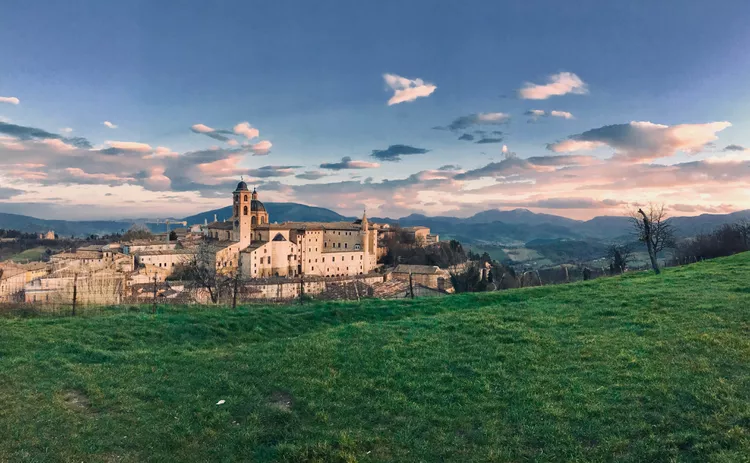Le Marche Region Overview
The Le Marche region, sometimes referred to as the Marches in English, is one of the more remote regions of Italy and sees fewer tourists than its neighboring regions. Le Marche is bordered on the east by the Adriatic Sea, and the tiny country of San Marino juts into part of the northern Marche. Its border touches five Italian regions:
- Emilia Romagna is situated north of Le Marche.
- Tuscany has a small portion of eastern Tuscany bordering Le Marche.
- Umbria, to the west, shares the largest border with Le Marche.
- Lazio borders Le Marche to the southeast.
- Abruzzo is located south of Le Marche, making it another remote region.
Le Marche boasts a varied and beautiful landscape featuring coastline, hills, and mountains. The coastal area is populated with sandy beaches, whereas the Sibillini National Park can be found in the mountains to the southwest. Numerous hill towns are scattered throughout the sparsely populated hills between the coast and mountains. Although the beaches can become crowded in summer, the inland areas remain relatively quiet, making them ideal for visits almost year-round. The best months for visiting are May, June, and September.
Top Towns and Cities

Ascoli Piceno, located in southern Marche, is a captivating town surrounded by rivers featuring an impressive main square and beautiful architecture. The town hosts a historic jousting tournament called La Quintana on the first Sunday in August, which is preceded by a grand parade with attendees dressed in period costumes. Nearby, you can explore Offida, known for its lace-making.
Urbino is another prime destination in Le Marche, renowned as the birthplace of the painter Raphael. The town’s historic center is a UNESCO World Heritage Site. It features the magnificent Ducal Palace, which houses the National Gallery of the Marche, showcasing one of Italy’s finest collections of Renaissance art.
Urbania is a lively medieval town situated along the Metauro River, not far from Urbino. It boasts an impressive Ducal Palace, originally a 13th-century fortress, and offers a fascinating museum with paintings, ancient maps, and ceramics. Urbania is well-known as one of Italy’s top locations for ceramics. An unusual display of mummies can also be found in the Chiesa dei Morti.
Mercatello sul Metauro, located near Urbania, is a lesser-known gem where you can experience authentic local life. This part of Le Marche is famous for its fall truffles, with a significant truffle fair taking place in Sant’ Angelo in Vado each October.
Frassasi Caves, known as Grotte di Frasassi, are among Italy’s most magnificent caverns. A guided tour leads you through the most extraordinary rooms of these caverns. Additionally, the town of Sassoferrato, found nearby, features several interesting attractions, including the Museum of Roman Gilded Bronzes.
Jesi serves as the heart of the Verdicchio wine region, famous for producing one of Italy’s finest white wines. The town is surrounded by impressive 14th-century walls built on Roman foundations, housing numerous exquisite buildings and squares in both Baroque and Renaissance styles. The Teatro Pergolesi hosts the fall opera season along with various cultural and musical events.
Macerata is a medieval walled town home to the Universita degli Studi di Macerata, which attracts students globally. Macerata features one of Italy’s largest museums dedicated to nativity scenes, the Museo Tipologico del Presepio, as well as an art museum, natural history museum, and a carriage museum. It also hosts an opera festival and open-air jazz performances during the summer months.
San Leo is a historical town that was part of the Marche region but was reclassified into Emilia Romagna in 2009; however, it remains a visitable site during a trip to the Marche. The towering fortress of San Leo sits on a rocky hill and can be reached by a hike from the town.
Adriatic Coast Towns

Ancona is a large seaside city built on two hills, with its harbor situated between them. Throughout history, Ancona has been settled by both the Greeks and Romans, becoming an important port during the Middle Ages. Despite being bombed in World War II and affected by an earthquake in 1972, many of Ancona’s historical structures still stand, and the higher parts of the town offer excellent views.
Fano, which was once the Roman colony of Fanum Fortunae, is a small fishing port and seaside resort located between Ancona and Pesaro. A Roman arch marks the entrance to Fano’s historic center, where visitors can explore a central piazza featuring a 16th-century fountain. The popular northern beach is sandy and lined with umbrellas and deck chairs, while the pebble-strewn southern beach offers a long promenade.
Pesaro, situated along the coast, is an attractive resort town known for its numerous hotels and excellent seafood restaurants. The beaches in the central area are lined with umbrellas and deck chairs that require payment, but free beaches can be found just north and south of the central area. Pesaro’s main square is vibrant and lined with bars, showcasing a stunning Renaissance palace, an art museum, and a museum dedicated to Renaissance and Baroque pottery. The cathedral features a captivating mosaic floor.
Gradara, located just inland from Pesaro, boasts well-preserved town walls complete with towers, visible from the coast. Visitors can park at the base of the town and walk along the main street through the city gates to the impressive castle at the summit. This town is known for its numerous souvenir shops.
Loreto, situated near the coast, is a significant religious town that houses one of the world’s most important shrines to the Virgin Mary, believed by many to have once inhabited the area. Each year, thousands of pilgrims visit Loreto, with the Santa Casa, or Shrine of the Holy House, containing numerous prominent works of art.





